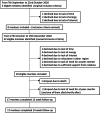Peer-mentor support for older vulnerable myocardial infarction patients referred to cardiac rehabilitation: single-arm feasibility study
- PMID: 35945611
- PMCID: PMC9360730
- DOI: 10.1186/s40814-022-01141-w
Peer-mentor support for older vulnerable myocardial infarction patients referred to cardiac rehabilitation: single-arm feasibility study
Abstract
Background: The positive effects of cardiac rehabilitation are well established. However, it has an inherent challenge, namely the low attendance rate among older vulnerable patients, which illustrates the need for effective interventions. Peer mentoring is a low-cost intervention that has the potential to improve cardiac rehabilitation attendance and improve physical and psychological outcomes among older patients. The aim of this study was to test the feasibility and acceptability of a peer-mentor intervention among older vulnerable myocardial infarction patients referred to cardiac rehabilitation.
Methods: The study was conducted as a single-arm feasibility study and designed as a mixed methods intervention study. Patients admitted to a university hospital in Denmark between September 2020 and December 2020 received a 24-week peer-mentor intervention. The feasibility of the intervention was evaluated based on five criteria by Orsmond and Cohn: (a) recruitment capability, (b) data-collection procedures, (c) intervention acceptability, (d) available resources, and (e) participant responses to the intervention. Data were collected through self-administrated questionnaires, closed-ended telephone interviews, semi-structured interviews, and document sheets.
Results: Twenty patients were offered the peer-mentor intervention. The intervention proved feasible, with a low dropout rate and high acceptability. However, the original inclusion criteria only involved vulnerable women, and this proved not to be feasible, and were therefore revised to also include vulnerable male patients. Peer mentors (n = 17) were monitored during the intervention period, and the findings indicate that their mentoring role did not cause any harm. The peer-mentor intervention showed signs of effectiveness, as a high rate of cardiac rehabilitation attendance was achieved among patients. Quality of life also increased among patients. This was the case for emotional, physical, and global quality of life measures at 24-week follow-up.
Conclusion: The peer-mentor intervention is a feasible and acceptable intervention that holds the potential to increase both cardiac rehabilitation attendance and quality of life in older vulnerable patients. This finding paves the way for peer-mentor interventions to be tested in randomized controlled trials, with a view toward reducing inequality in cardiac rehabilitation attendance. However, some of the original study procedures were not feasible, and as such was revised.
Trial registration: The feasibility study was registered at ClinicalTrials.gov ( ClinicalTrials.gov identification number: NCT04507529 ), August 11, 2020.
Keywords: Cardiothoracic nursing; Coronary heart disease; Inequalities in health; Lifestyle; Mentors; Patient participation; Patient perspectives; Quality of life; Rehabilitation; Self-efficacy.
© 2022. The Author(s).
Conflict of interest statement
The authors declare that they have no competing interests.
Figures





References
-
- Pedersen M, Støier L, Egerod I, Overgaard D. Mastery of everyday life and social support needs in older vulnerable women with myocardial infarction and their relatives: a qualitative study. Eur J Cardiovasc Nurs. 2021. 10.1093/eurjcn/zvab014. - PubMed
Associated data
Grants and funding
LinkOut - more resources
Full Text Sources
Medical

